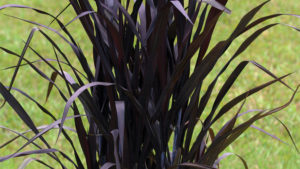Now is the Time for Growers to Plan for Fall Perennial Planting

Schizachyrium ‘Standing Ovation’ and other grasses combine with other annuals and perennials to add interesting form and texture to landscape plantings. Photo courtesy of North Creek Nurseries.
There are many correlations between our industry and the fashion world. One of the biggest is the constant need to plan six months in advance — or more — for each upcoming season. Perennial planning for fall should be twofold:
• Booking perennial product for fall sales alongside traditional fall crops like pansies and mums
• Booking perennial liners and bareroot inputs to grow on for sales the following spring
Plant orders for perennials might include late summer and fall items such as Sedum telephium ‘Autumn Joy’ (an oldie but goodie) or any of the newer genetics of fall-flowering sedum. Other candidates to consider are ornamental grasses (Miscanthus spp. or Panicum spp.), Helenium spp. (awesome fall colors), Rudbeckia hirta (while not truly a perennial in many areas, it may reseed), Rudbeckia ‘Goldsturm,’ and more.
Five Tips to Increase Fall Perennial Sales
1. Integrate perennials into your fall combination planters. Ornamental grasses work particularly well in mixed containers, either as the central or side component. Grasses can pair well with a range of annuals and perennials, lending interesting habit, form, and texture, with the added bonus of colorful racemes when the plant flowers. Examples of this, depending on your location, might include Pennisetum ‘Princess,’ Miscanthus ‘Morning Light,’ Schizachyrium ‘Standing Ovation,’ or even juncus.
For consumers who build their own combinations, make sure your retail display includes ideas and examples of how to incorporate perennials and grasses. Take a look at some of the dark-foliaged annual pennisetum to add a dramatic look into fall containers and landscapes, for example. They can set off the reds, oranges, and yellows that encompass the fall color palette.
Don’t rule out grasses for shade pots either. Choices such as hakonechloa and carex, for example, can do well in shade and offer beautiful flowing habits.
2. Seize the second-spring with spring-flowering crops that benefit from fall planting. For example, plan on a new crop of peonies (and spruce up the old), herbaceous or tree, and promote the benefits of planting them in fall.
Retailers, remind your customers that fall is a great time to plant new perennials or revitalize older plantings. September is generally considered the best time to plant or divide peonies, for example.

The dark foliage of Pennisetum ‘First Knight’ can add drama, texture, and form to fall containers and landscapes. Photo courtesy of Emerald Coast Growers.
3. Offer your retail customers an educational seminar around fall perennials for a nominal fee, perhaps giving them a discount coupon when they attend. Highlight the items looking exceptionally good on your seminar day, and book your production with that date in mind. Your perennial sales that day are sure to increase.
4. Let your customers know that the pollinator bandwagon doesn’t stop in June, and hummingbirds and insects are still looking for nectar and pollen sources well into the fall. Fall perennials and annuals are important food sources, so remind customers of the need to plant for multiple seasons now, and refresh some of their tired plantings from spring. I’ve seen hummingbirds at my tall annual salvias into September and October. The bee populations tend to be highest in the fall, so those fall asters, sedum, and helenium are even more important.
5. Many growers and retailers use fall as a time to put their old plants on sale. In theory, this isn’t a bad idea. Those plants, however, should be considered with a critical eye. If they look terrible, they’re better off in the compost pile rather than taking up valuable bench space. Poor-looking product does your reputation no favors; if you can’t clean it up, pitch it out.
Consider giving new life to older stock, as mentioned above. Can you bump a few items into mixed containers and give them an all-new view? Miscanthus or panicum, mixed with some sedum, pansies, and even some ornamental kale, can take you from a dud to a wow in just a few steps.
Forward Thinking to Spring Ahead
On to the second half of the perennial planning equation: the items you’ll need to pot up in the fall for spring sales. This includes anything that flowers in the spring, as well as items you want to size up for exceptional container fill. Items such as aquilegia, dianthus, and iberis, for example, should be brought in so they can get well established before going into dormancy.
Very broadly thinking, growers in northern states want these crops potted up by late August or early September; growers in southern states want to plan for October or early November. If you wait much longer, you’ll run into shorter days and plants beginning to shut down for the season. The goal is to encourage some new growth to get good pot fill, and time to harden off, before the onset of short days and cold temperatures.
Another consideration when planning your perennial orders for fall is availability.
Breeders and young-plant producers generally release their spring collections for the next season in July. Connect with your supplier early to begin planning for the new items that you’ll offer in fall, or spring the following year.
Don’t be left in the cold. If you wait too long, you may miss out on that cool new daylily or that hot new campanula. Order early is a good mantra to follow for both new up-and-comers and the bread-and-butter items. Planning ahead also positions you to take advantage of any early order discounts that might be offered.








